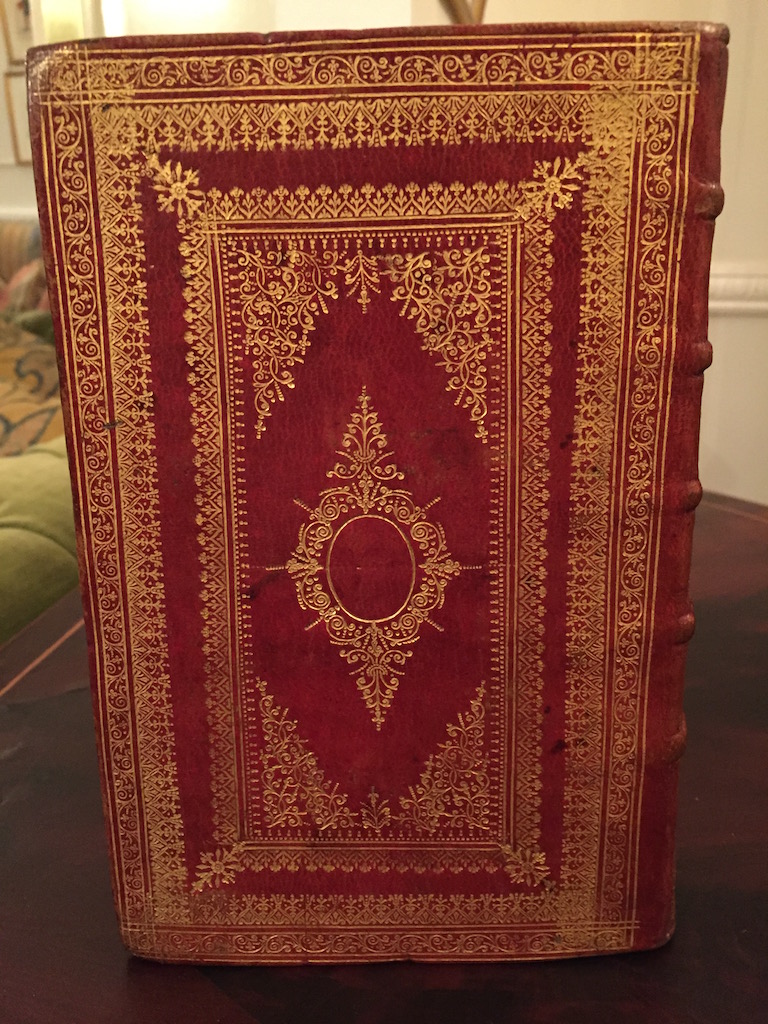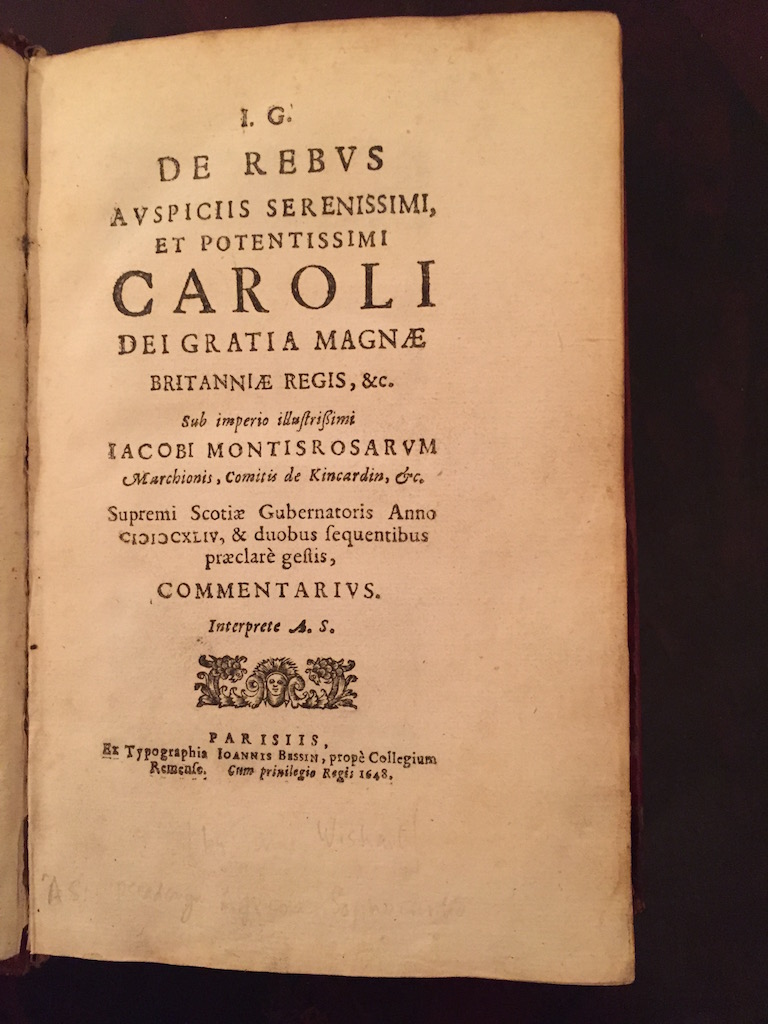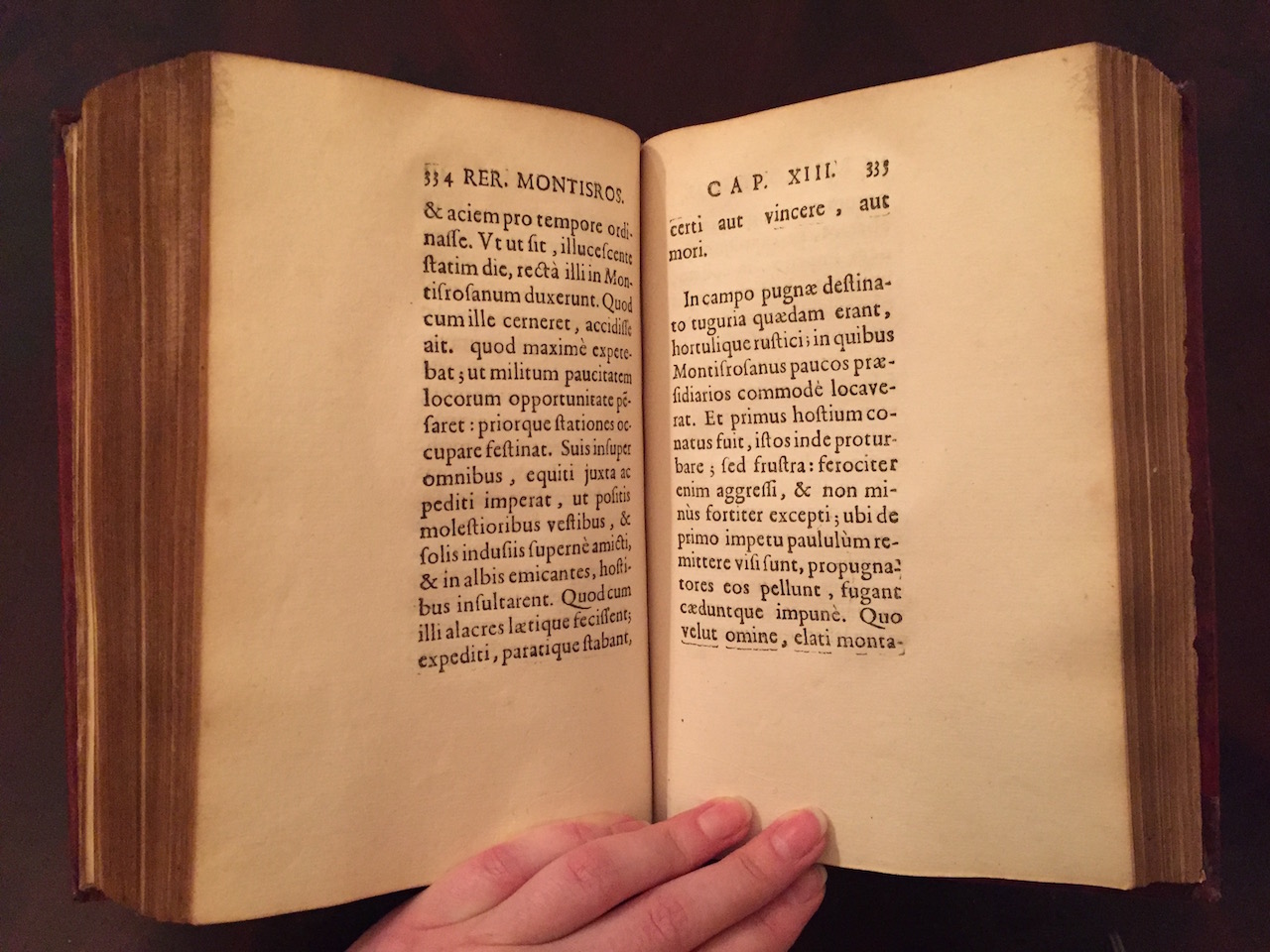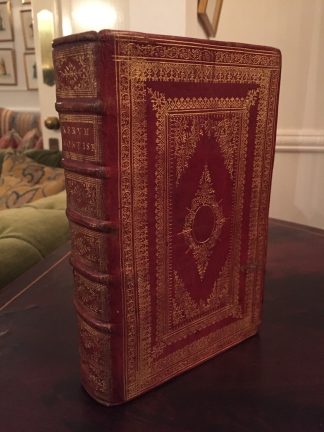WISHART, George
I.G. de rebus auspiciis serenissimi, & potentissimi Caroli gratia magnæ Britanniæ, &c. sub imperio illustrissimi Iacobi Montisrosarum marchionis…: Supremi Scotiæ gubernatoris anno 1644, & duobus sequentibus præclarè gestis, commentarius
Paris, ex Typographia Ioannis Bessin, propè Collegium Remense, 1648£4,250.00
8vo. pp. (xxiv), 563 (i). Large paper, Roman letter, some Italic. Woodcut and typographical headpieces, small woodcut initials, printed label, ‘6506’ from the sale of Bolongaro-Crevenna at head of front pastedown, bookplate of Robert Maxtone Graham below. Light age yellowing, the very rare marginal spot. A fine, large paper copy in exceptional contemporary French red morocco in the style of Le Gascon, covers double gilt ruled to a panel design, outer panel filled with a fine scrolled roll, middle panel with two fine dentelle scrolls elaborate fleurons to corners, central panel bordered with a small pointillé roll, elaborate corner pieces with scrolled and pointillé tools around a central oval worked to a lozenge form with fine scrolled tools, spine richly gilt with gilt ruled raised bands, double gilt ruled with further pontillé rules to compartments, richly gilt with scrolled tools and semé of small tools, edges with gilt dentelle roll, combed marble endpapers.
A fine, large paper copy of this most interesting contemporary biography of the feats of the great Scottish General, James Montrose, in a stunning contemporary morocco binding attributable or very close to the great French binder Le Gascon, from the exceptional library of Bolongaro-Crevenna. “Dr. George Wishart was born in 1599… In 1626 he moved to St. Andrews as second charge, and it has been conjectured that is was there that he first met the Earl of Montrose, who matriculated at the University of St. Andrews in 1627… When the Presbyterians obtained the ascendancy, Dr. Wishart fled to England with Archbishop Spottiswood. On 19th October 1639, he was appointed to a lectureship of All Saints Church, Newcastle, and in 1640 he was presented at St. Nicholas Church, Newcastle. When Leslie and the Scots army took Newcastle on 19th October 1644, Wishart was taken prisoner, and, on the charge of corresponding with royalists, was imprisoned in the Thieves’ Hole, Edinburgh. After 7 months in prison, Wishart was liberated when the Marquis of Montrose arrived in Edinburgh after his victory at Kilsyth on 15th August 1645. Wishart joined the royal army at Bothwell, and was appointed private chaplain to the Marquis of Montrose. In this capacity he accompanied the Marquis in his campaign both at home and abroad, and his narrative of Montrose’s campaign is that of an eye-witness and biographer. It was first published in Amsterdam … 1647. When the Scottish Parliament tried Montrose in abstentia in 1649, Wishart’s book was brought as evidence against him. A bounty was pledged by Parliament and the Church of Scotland for his capture, and he was sentenced in abstentia to be hanged with Wishart’s book around his neck. The sentence was carried out in the following year after Montrose was captured and brought to Edinburgh.” The Wishart Society.
“Les reliures de Le Gascon sont de veritables objets d’art.” Edouard Rouveyre. ‘Connaissances nécessaires à un bibliophile.’ This binding is very similar in style and the tools are nearly identical to a binding attributed to Le Gascon in a Sotheby’s sale at Paris, 2011, sale PF1113, lot 51, the 1595 edition of the works of Montaigne. It shares the same oval centre surrounded by near identical scrolled tools and pointillé work. “The style of Le Gascon, so-called, was in vogue between the years 1640, and 1665” Herbert P. Horne ‘An Essay in the History of Gold-Tooled Bindings’.
The binding is also very similar in design and tools to another binding attributed to Le Gascon in the Tenschert Catalogue ‘Biblia Sacra’ 2004, no. 59, a Greek New Testament. Many of the best binders of the period imitated the work of Le Gascon, who was then at the height of fashion, and if this binding is not by Le Gascon or his atelier, it is by someone who was imitating him as closely as possible. The gilding and use of pointillé tools is particularly fine, the morocco is of the highest quality. As this is a large paper copy in a very rich binding, it was almost certainly made for presentation, though there is no indication of to whom.
A wonderful copy from the extraordinary library of Bolongaro-Crevenna, the francophile Italian merchant from Amsterdam, whose magnificent collection was sold in Paris between 1775 and 1793. This work was in his sale of History books in 1789 lot 6506; see ‘Catalogue des livres de la bibliothèque de M. Pierre Antoine Bologaro-Crevenna … Volume 4” Amsterdam, chez Changuion 1789.
In stock










